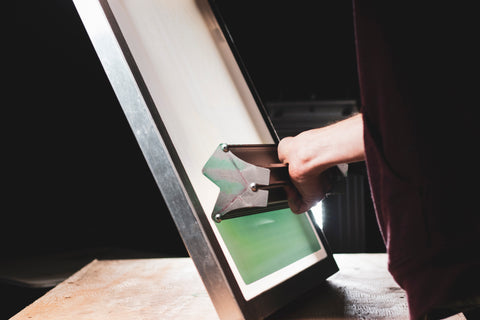Size matters in screen printing. But it’s not just about how big your press or conveyor is. The sizing of all your equipment and supplies is important, even down to squeegees and scoop coaters. If you’re having issues when coating screens or getting a good print, it might not be your technique. You might just not have properly sized supplies for the job. So what size scoop coater and squeegees should you use? What can happen if you don’t use the right size? Let’s find out.

Photo by Symmetree Clothing
PROPER SCOOP COATER SIZING
Finding the best scoop coater size for a screen shouldn’t be rocket science. You want the scoop coater to fit within the back, or squeegee side, of the screen comfortably. If the coater is too large, you’ll hit the frame and won’t even be able to coat the squeegee side of the screen with emulsion. You won’t be able to get an even deposit of emulsion on the mesh.
Make sure the scoop coater is small enough that it doesn’t hit the frame of the screen. You don’t want to go too small, though. If the scoop coater is too small, you won’t be able to coat enough of the screen to burn the image onto. Coating one half of the screen and then the other seems like it’ll work in theory, right? You’ll end up with a thicker coat of emulsion where the two halves overlap, which will make reaching proper exposure difficult.
Basically, you need the right size scoop coater for the screen you’re using. The good news is that scoop coaters come in a range of sizes, and unless you’re using every size screen in your shop, you’ll probably only need one or two different scoop coaters.
SCOOP COATER & SCREEN SIZE CHART
Here’s a quick guide to finding the right size scoop coater for the screen you’re using:
- 16x20 screen: 16 in. coater (coat the screen sideways, or landscape)
- 20x24 screen: 16in. coater
- 23x31 screen: 19in. coater
- 25x36 screen: 20in. coater
- 42x48 screen: 24in. coater
RELATED: HOW TO MAKE A BETTER SCREEN FOR SCREEN PRINTING
Now that you’ve got the proper scoop coater size for the screens you’re using, you can burn screens with confidence and get to the press.

PROPER SQUEEGEE SIZE
Squeegee sizing isn’t too different from scoop coater sizing. The squeegee should fit on your screen without overlapping with the frame. Since you’ll be pulling or pushing the squeegee on the back of the screen, it needs to fit comfortably on the screen.
The squeegee should be about an inch larger than the image area on either side. When you pull a squeegee, it pushes unused ink to the sides of the screen. If the squeegee is smaller than the image area, this can leave a raised ink deposit on the image. You’ll need to do a second pass at an angle to make sure no ink ends up in the image area as you print.
There are lots of different squeegee sizes: from 2” to 72”. Most manual screen printers use a squeegee that’s 12”-14”. This size will work for pretty much anything. Don’t worry too much about using a squeegee that’s longer than necessary. For example, an 8” design can be printed with a 14” squeegee.
What about left chest designs? The average left chest print is no larger than 4” wide. For these types of prints, use a 6” squeegee. That will give you the 1” gap on either side of the print, and you can focus on speed without worrying about the consistency of your squeegee.
For oversized prints, you’ll need a larger squeegee. Oversized prints require larger screens, too. Your squeegee should still fit on the screen as you print a larger design. A 16” or 18” squeegee can handle pretty much any oversized job you’ll be printing on a manual press.
RELATED: THE TOOLS NEEDED FOR OVERSIZED PRINTS

WHAT HAPPENS WHEN YOU USE THE WRONG SIZE SQUEEGEE?
If you use a squeegee that’s too big, you’ll run the risk of hitting the frame and potentially popping the mesh out of the screen. If your squeegee is too small, you’ll have to get creative so as not to leave a line of ink in the middle of the image area.
While you can use a giant squeegee on a small design, you’ll need to make sure the squeegee won’t interrupt anything on the shirt. If the squeegee is running over pockets or seams, you’ll need to grab a smaller squeegee. It’s all about finding the best squeegee for each job.
RELATED: HOW TO CHOOSE THE PROPER SQUEEGEE BLADE DUROMETER

There’s a reason screen printers have so many different squeegees. Each job requires something a little different. Coating a screen with the proper scoop coater helps to lay down a great base layer and eliminate stress-inducing problems. The last thing you want is to keep coating screens because your scoop coater isn’t doing the trick. Scale your scoop coaters and squeegees to the design and screens you’re using. It’ll save you time and stress.

